A Lofty Life
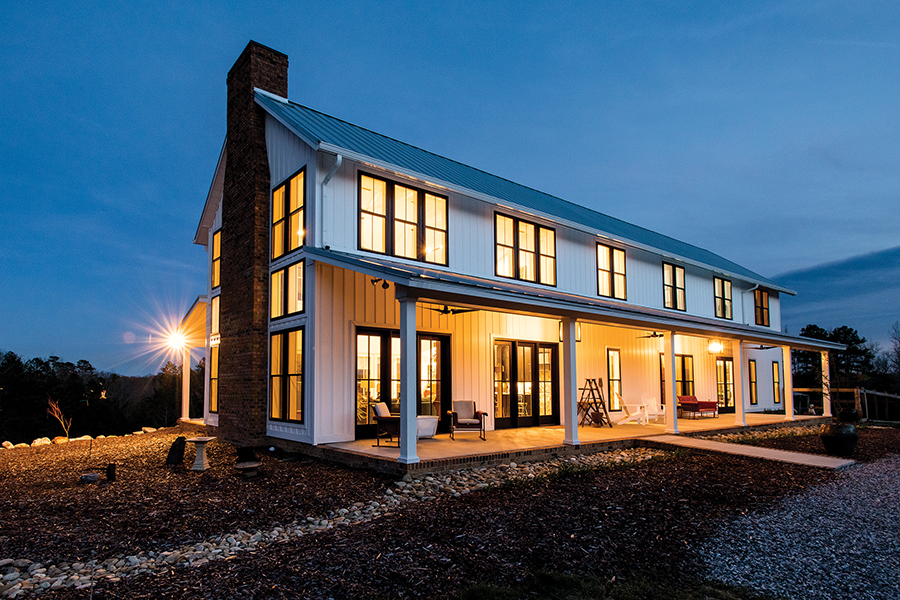
What’s black and white and artistic all over? The barn-inspired home of Janine Wagers and Ty Pruitt
By Maria Johnson Photographs by Amy Freeman
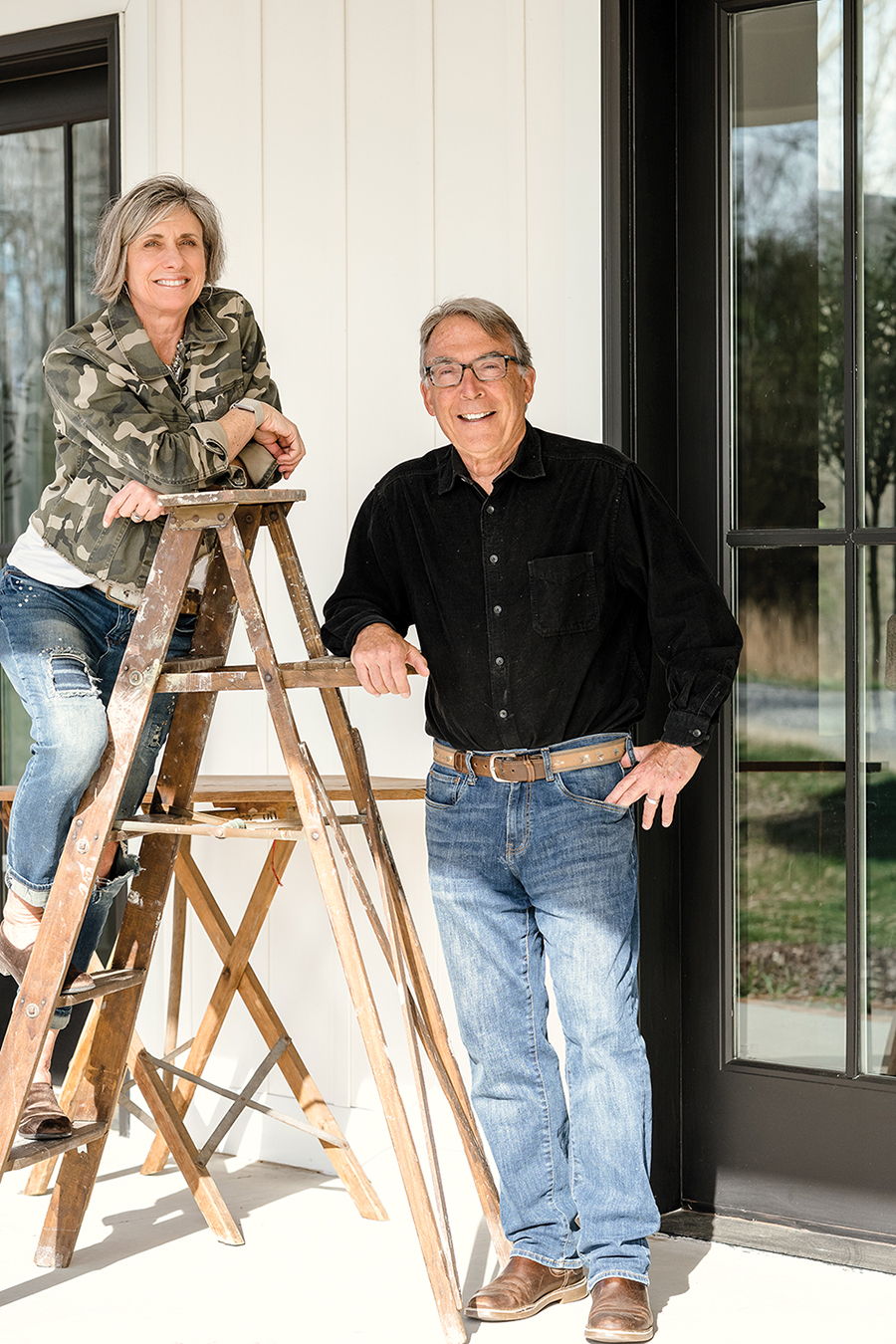
She drove the building contractor and subcontractors crazy, she admits.
But Janine Wagers knew what she wanted her and her husband’s new home to look like: a barn.
A gussied up barn, to be sure. Stylish. On point. Artistic. But still, a barn.
“A modern barn,” Wagers says.
Design-wise, she was confident she could mold the details, inside and out, to achieve the desired effect. After all, she’s the director of visual merchandising for High Point-based Universal Furniture, a stalwart of the contemporary furniture world.
A 38-year veteran of the industry, Wagers supervises all-things-eyeball in the company’s massive local showroom, open to trade customers only, and on other carefully curated sets around the country.
Comfy in a barrel-back chair covered with plush lavender, she pauses our interview to take a call about an upcoming show in the Hollywood Hills to promote a new line of furniture bearing the name of Australian model Miranda Kerr. The line is sold exclusively through retailer One Kings Lane, a collaborator in the show.
She hangs up and apologizes for the four cats and three dogs that rush inside through a door that she has left open. There’s a brisk breeze outside, and, well, why not invite it in, too? Flies? No worries. She uses a leaf blower to knock their bodies off the upper window sills, should they not find the exits.
“Welcome to the funny farm!” she announces.
The farm part is true. The home of Wagers and her husband, Ty Pruitt — who retired from the veneer business last year — occupies land that belonged to a working farm in northeast Davidson County in the not too distant past.
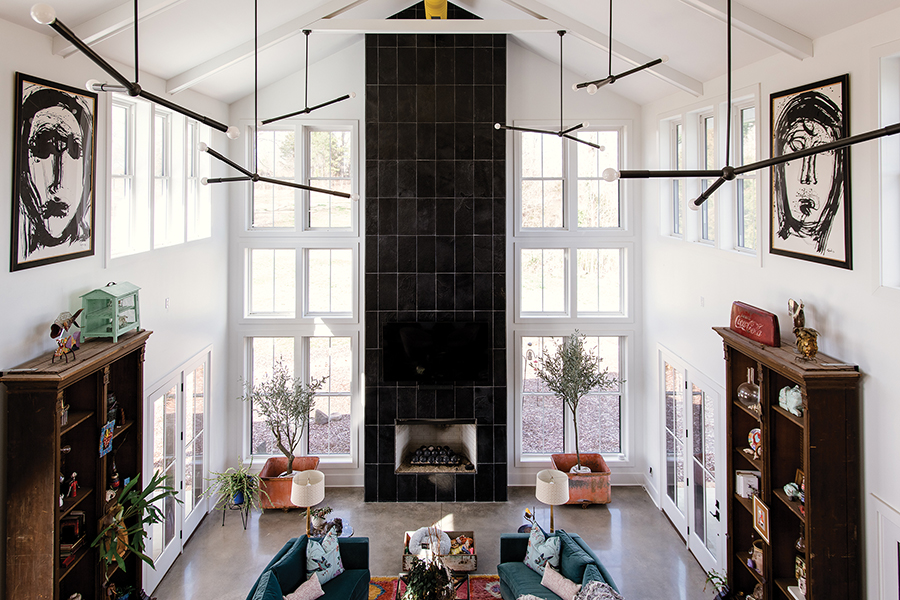
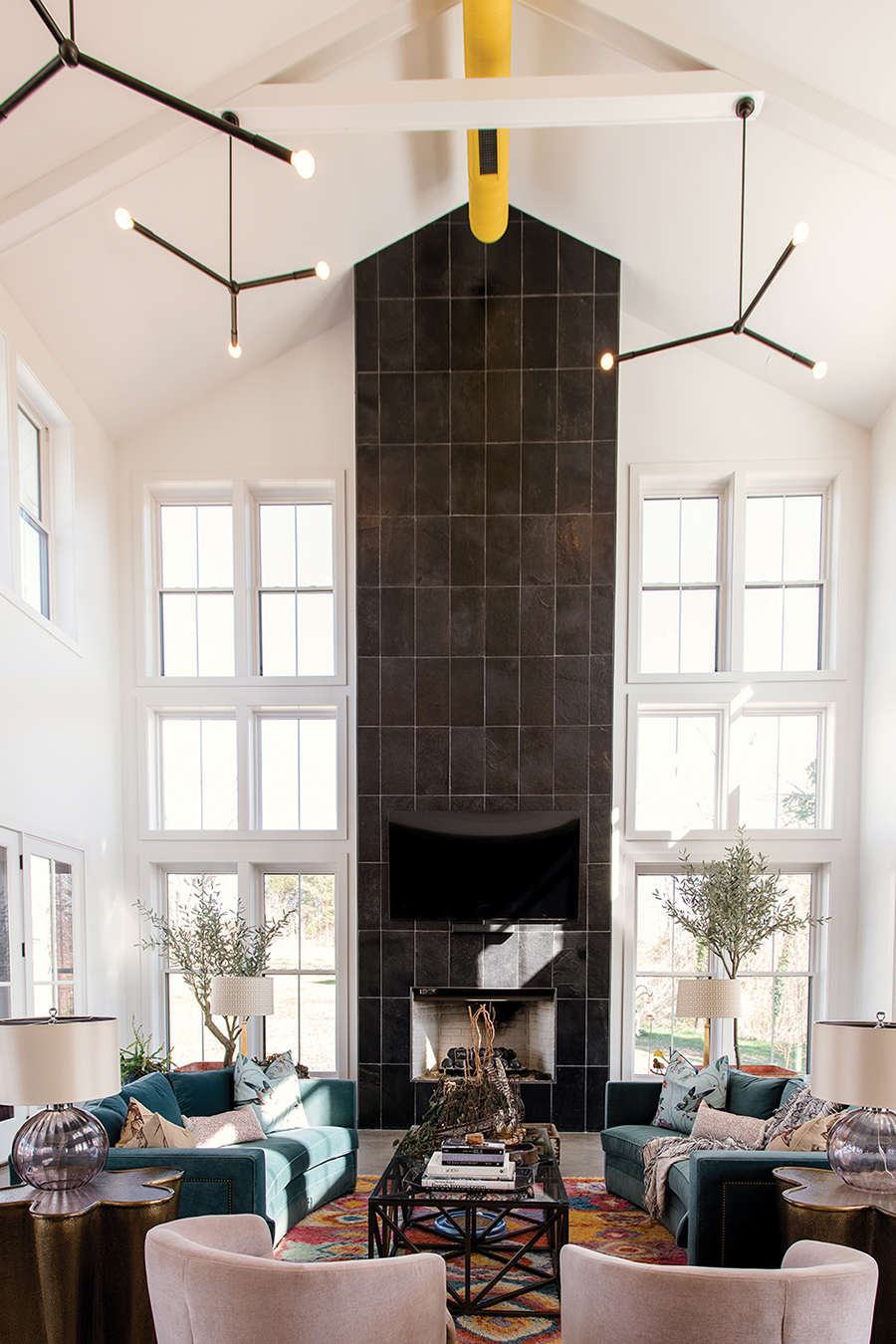
A horse barn stood on the graveled flat that doubles as the home’s front yard and parking area. The old barn had collapsed by the time the couple bought their 50-acre parcel in 2019. They paid someone to raze the structure before the 2021 construction of their new digs, a stylized homage to its vanished cousin.
Rooted in a simple rectangular footprint and flanked by lean-to porches, the three-bedroom, 3,300-square-foot home stands like a glowing beacon — with silver roof and milky board-and-batten siding — on a grassy hill. From this crest, Wagers and Pruitt look out, through 55 windows with nary a blind or drape, over the swells and troughs of their land. In most directions, horizon meets tree line
“It’s wonderful waking up in the morning. You can see the sun coming up. It’s very freeing,” says Wagers, who sits in the great room, which might be better described as a great big ol’ room.
It is vast, a white-walled space that soars 24 feet, past dangling geometric lighting fixtures, to the vaulted ceiling above. The expansive room is anchored to the Earth by thoughtful tethers, most notably a black, slate chimney chase that stretches all the way up one wall, gleaming like a monolithic monument.
Contractors worried about the weight of the slate.
You’ll figure it out, Wagers said.
They did.
The result: a visual wow that slacks the jaw and bends a smile in appreciation of creative nerve.
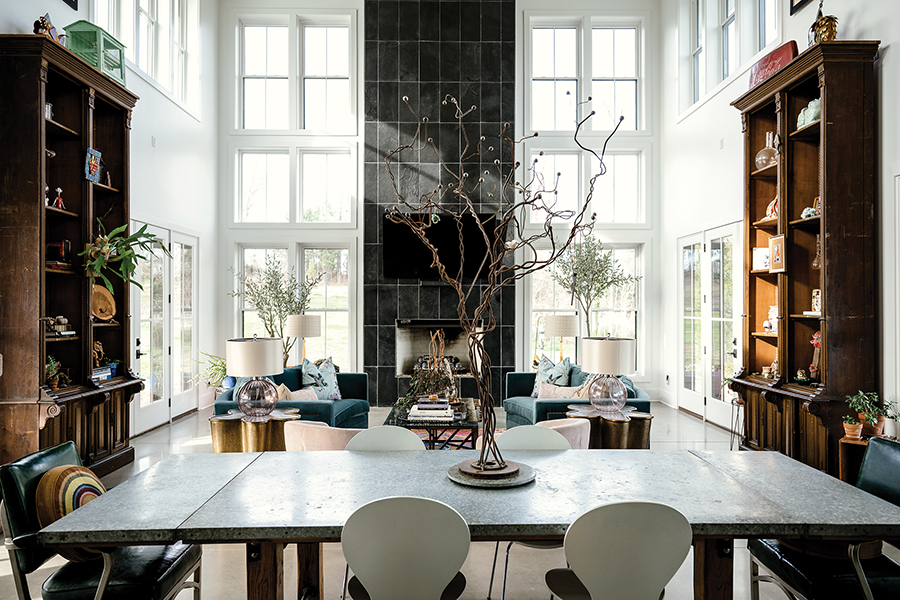
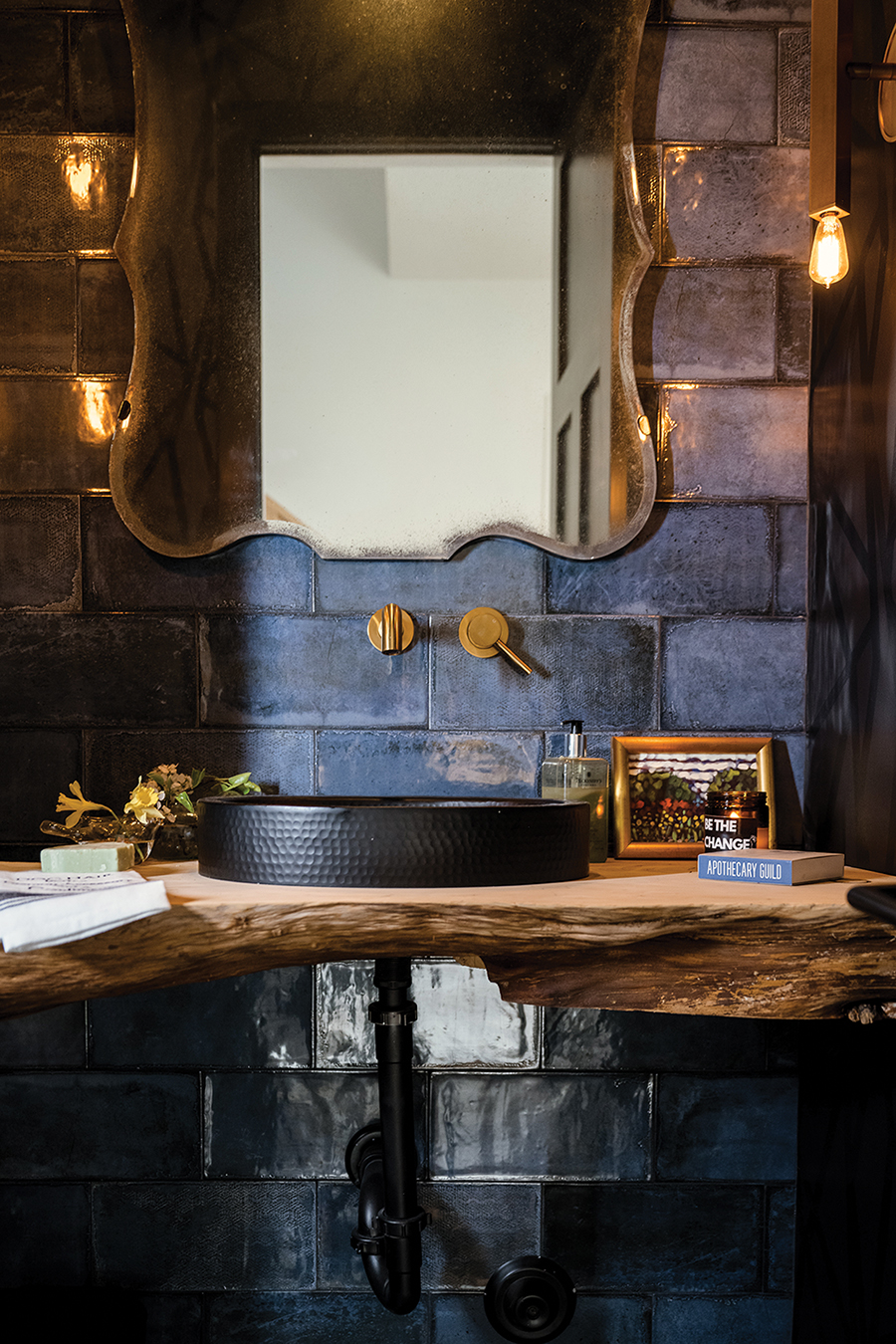
You could think of the home as a series of abstract paintings. Most of the canvases — walls in this case — are left blank, white. The frames, in the form of black-mullioned windows and other hard lines, are inky. The energy comes from splashes of color, in this case furniture and accessories, and from Wagers herself.
A fusion of down-home and up-to-date, she’s dressed in strategically ripped, cuffed jeans, a loose gray pullover and clear rectangular earrings. Her naturally gray hair, cut into a sharp A-line bob, still contains more coal than ash. Her eyes stand out like blue, steel rivets.
When she pours her honeyed Georgia accent (born in Dalton, schooled in Athens, go ’Dawgs) over her observations, you can’t help but laugh.
Example: The three-pronged lighting fixtures hanging overhead are called “talons” in the catalog.
“I call ’em chicken feet,” she muses. “But ‘talons’ is much more refined.”
She is surrounded by the trappings of her professional life.
Two curved, teal-green sofas face each other like parentheses in the center of the room. They clasp a shaggy, splashy rug and a glass-topped coffee table with a truss-like base. The end tables are amoeba-shaped pillars. All of the pieces, save the rug, are by Universal.
It makes sense. Wagers has spent the bulk of her career — a 10-year stint in the ’80s and ’90s and the current 15-year run — with the outfit.
But her home is no company showroom.
Ironically and honestly, Wagers pooh-poohs interiors that are lifted straight from showroom floors, especially if the cutting-and-pasting happens all at once.
Instead, she favors the picker approach. Pick the pieces you like. Fold them into what you have. Take your time. Don’t be afraid to veer off the designer-approved path into yard sales, flea markets, family attics, antique shops and consignment stores. See what calls to you.
Gradually, bring the pieces into concert. They should tell a story. Your story.
She has painted the couple’s own story with care and a keen eye.
“Want a tour?” she asks.
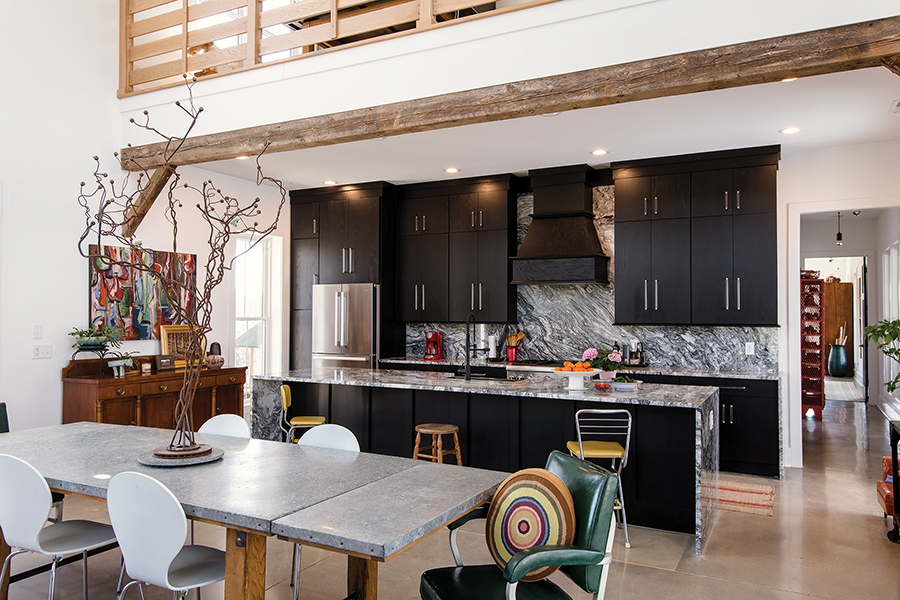
First stop, kitchen and dining area, which is really a part of the great big ol’ room, though the kitchen is technically tucked under a second-story loft that serves as the couple’s home office with side-by-side desks.
The overhang is underlined by a cosmetic beam salvaged from the barn that once sat outside.
Directly below, the metal-topped family table is headed by two office chairs, businesslike in gray steel and dark green Naugahyde, that were plucked from a Salvation Army store. As looser counterpoints, modular plastic chairs from Target line the sides. Wagers has her eyes peeled for replacement chairs. Ditto a new tabletop.
“I want to put a brass top on it,” she says.
She’s happier with the kitchen, where waterfall granite countertops fold over the island and base cabinets. The black wall-mounted cabinets extend to the 10-foot ceiling. She insisted.
The cabinets installers pushed back: “What will you do with the top cabinets?”
Wagers countered: “Store my once-a-year things. I have a folding ladder.”
She tilts her head back to eye the upper cupboards. Her grandmother’s stemware is up there, she assures. Word taken.
“The look is important,” she says of the cabinets.
Don’t confuse “the look” with perfection. Wagers not only tolerates imperfections, she insists on leaving the naturally occurring ones. She points to gouges in the sealed-but-unstained concrete floor. The contractor wanted to fill them with epoxy.
“I was like, ‘No! I like it messed up!’” she recalls.
The same goes for a section of the kitchen floor that had to be cut out to reach a clogged pipe. She taps the spot with the toe of a leopard print bootie. The patched floor is going to be a slightly different color, the concrete people warned.
Fine, she said.
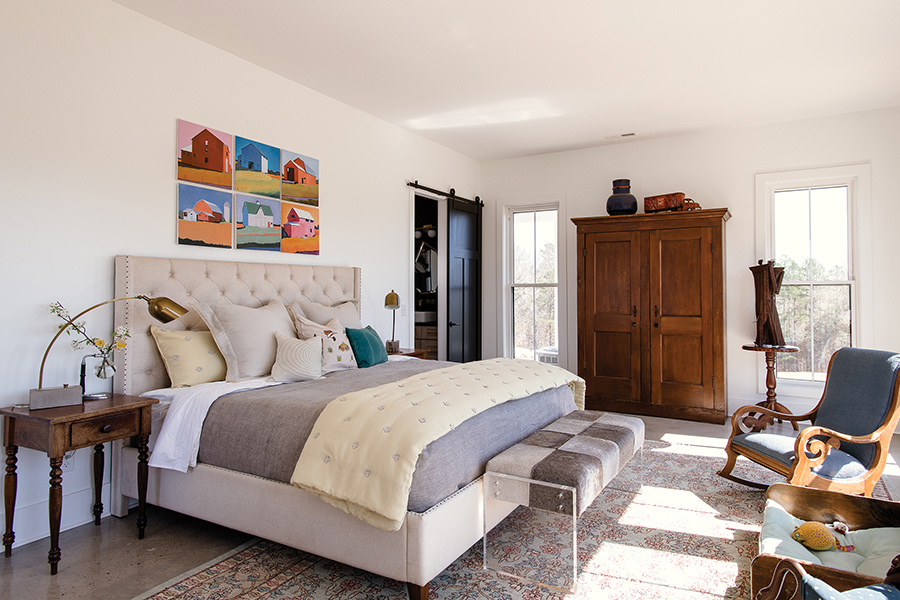
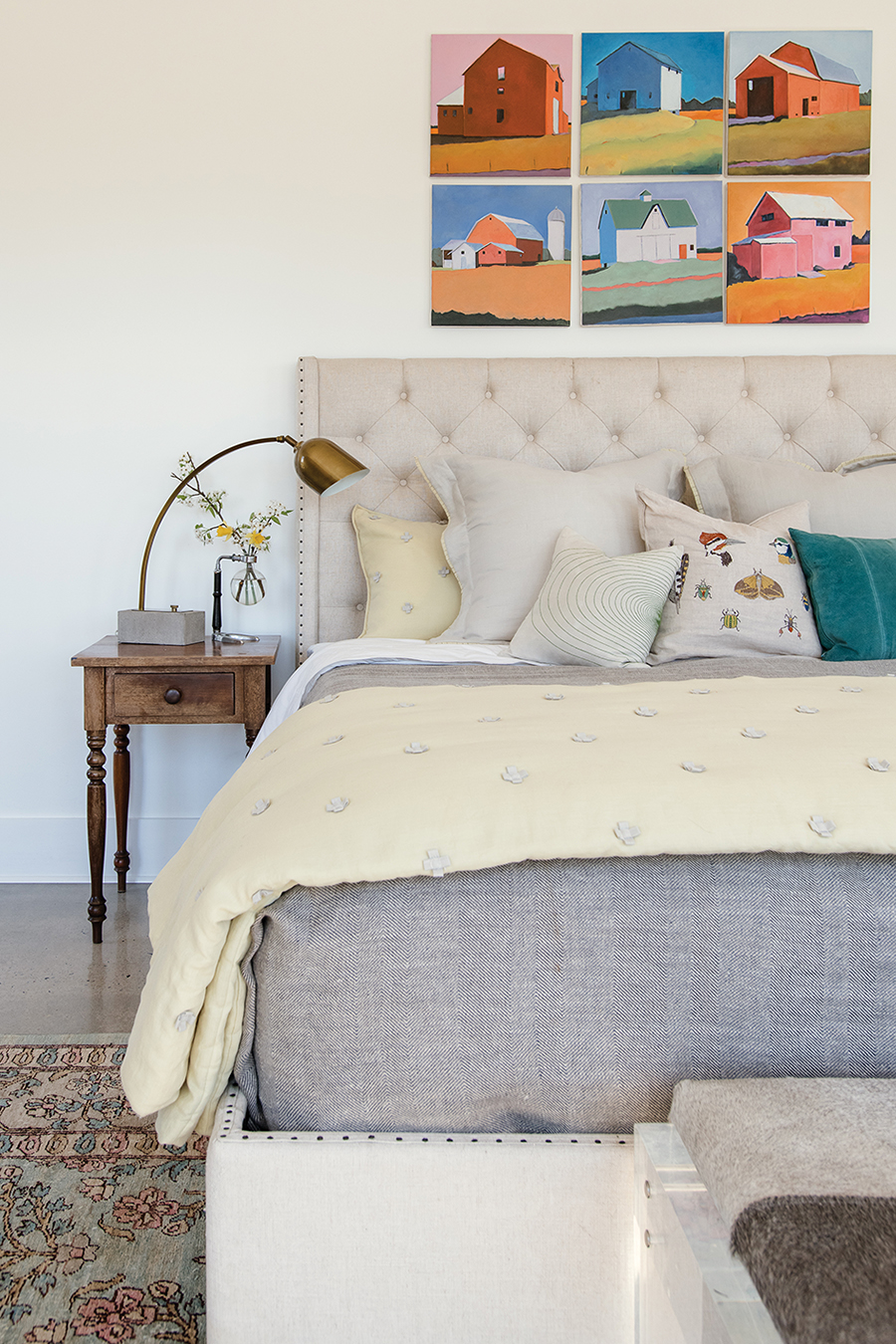
“I like defects,” she explains. “I find it easier to live life with defects.”
Her heels peck the imperfect floor as the tour proceeds past a gigantic blackboard where she and her granddaughter like to doodle everyday hieroglyphics in white chalk.
She stops at the powder room, an exception to the rule of blanched backgrounds. The room is a visual sink hole, but in a good way, sucking the eye into a dramatic statement uttered with black peel-and-stick wallpaper, navy-hued subway tile, smoky floor tile and a counter hewn from a cedar tree that Wagers saved from road-widening near the couple’s former home in Sedgefield. Most of the tree’s wood went into Universal pieces. She nabbed a nub.
“You can have fun with a powder room,” she says.
Click-click-click to the primary bedroom.
Does she mean the master bedroom?
Nope, that term is out, she says. Think about it.
Used to changing with the times, Wagers absorbs the update and moves on. The couple’s bedroom is simple and airy. Ballast comes from wooden wardrobes on opposing walls. The cabinets came from the school where her parents taught in Dalton, Georgia.
Chipped, dinged and dated with black-marker graffiti on the shelves, Wager’s free-standing closet is home to T-shirts, socks and other dresser staples. For hanging clothes, she and Ty share a walk-in closet in the bathroom. They use the same flat-bottomed tub and glass-enclosed shower, too, but they “go” their separate ways with his-and-hers toilet rooms.
“This is my favorite room in the house because it’s all mine,” she says. “Don’t come in here. Don’t use it.”
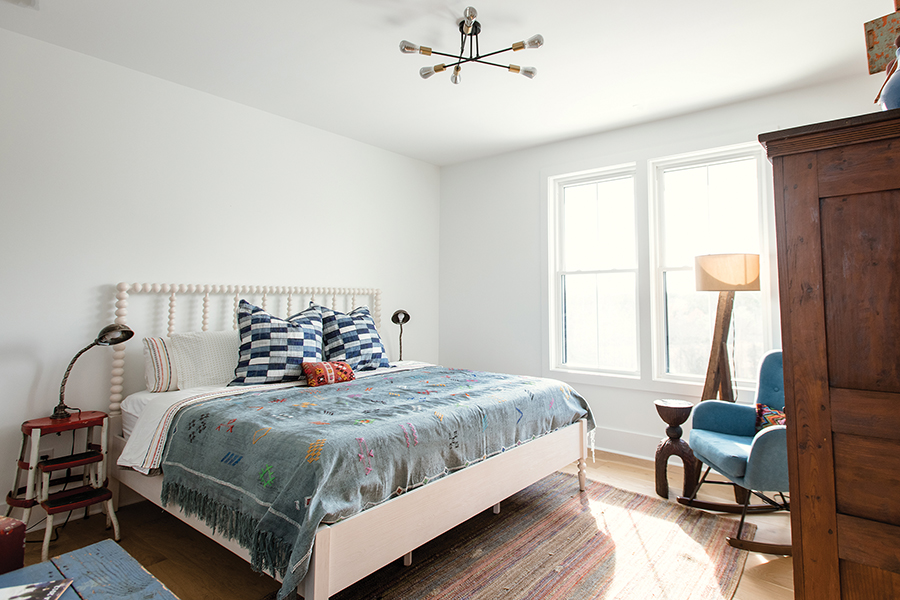
She has personalized the room with a wall full of necklaces that hang from nickel drawer pulls screwed directly into the wall. Practical. Funky. Changeable. A vertical playground.
That sense of fun permeates the house. One hallway pops with a bank of orange basket-style gym lockers found in a junk store. Their son, Will, used the array in his room while growing up.
More mirth lurks in an upstairs TV room, where a jigsaw puzzle sprawls on a lemony Formica table ringed by vintage Bertoia-style wire chairs. On a nearby wall, Wagers assembled a collage of family memories.
A watercolor painting by Will.
A plaque recognizing Ty’s service as Wolf Tribal Chief at the High Point YMCA.
A postcard with a wry drawing of eggs dripping from a shower head, a memory of the sulfur-smelling water they encountered in Iceland.
Wagers tinkered with more than a dozen pieces, hanging and rearranging until she was satisfied.
“What was the worst that could happen?” she shrugs. “A few extra holes in the wall?”
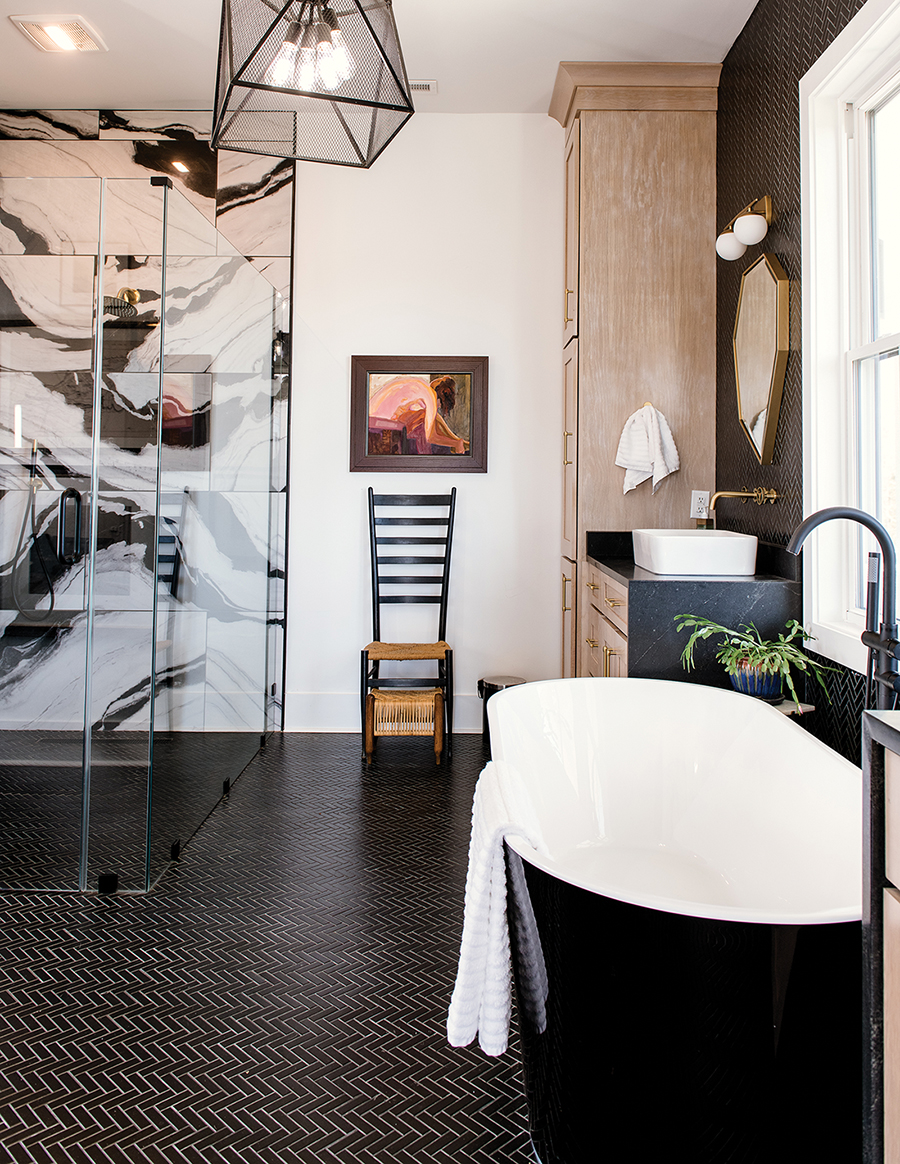
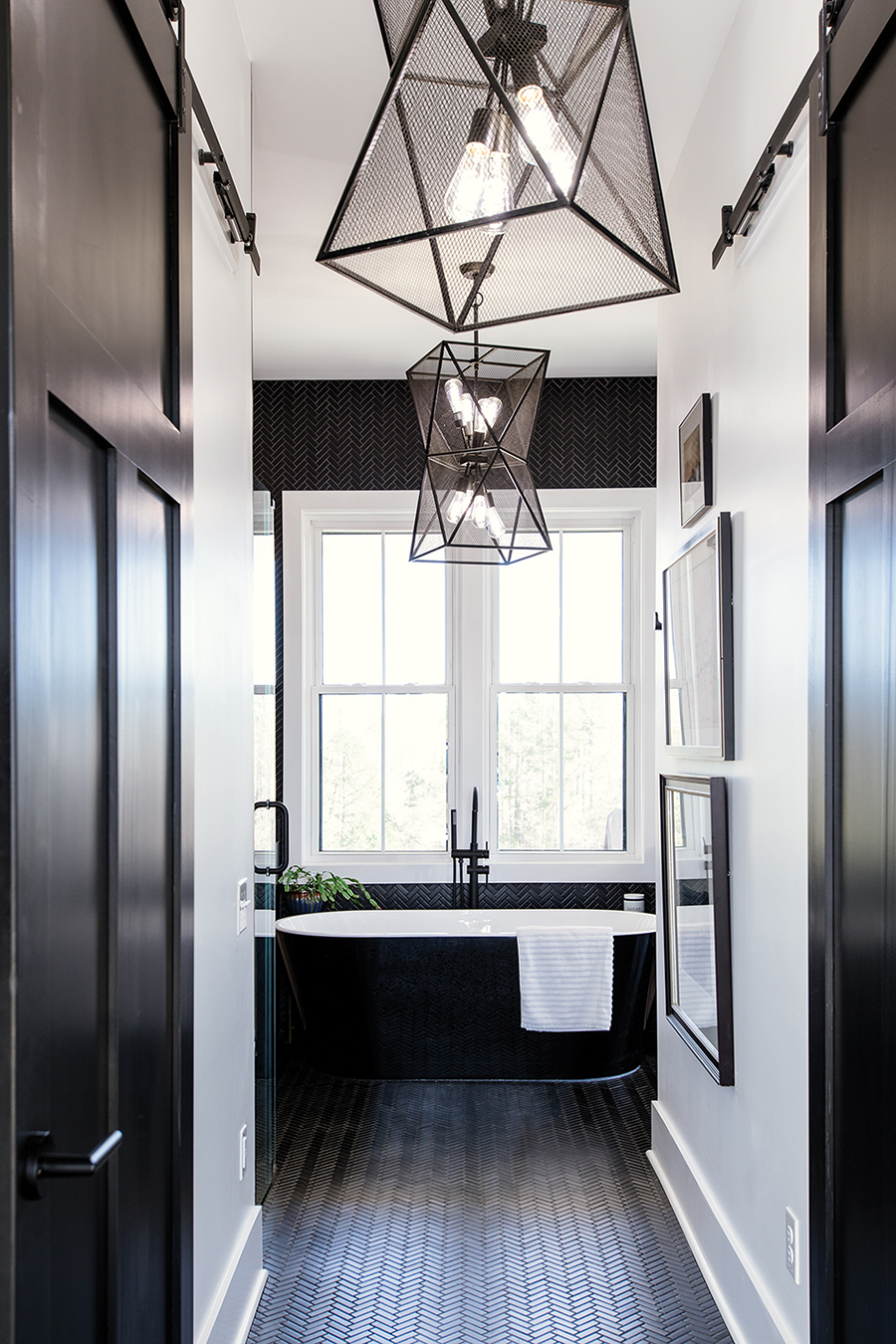
She was more deliberate with a gallery of family photographs that plaster both sides of another hallway, an allée of DNA.
“That’s my son. That’s my step-daughter. That’s my dad and his sister. That’s Ty when he was a baby,” Wagers says, pointing as she goes.
To get the composition right, she measured the frames — all in tawny tones — and laid them out on a computer. Most of the pictures are rendered in black and white, an intentional stroke. The exhibit includes a non-photographic item: a note written in ink and torn from a small memo pad.
“Janine, I love you. Grandma.”
Wagers’ grandmother pressed the paper into her hand when Wagers visited her in assisted living. Wagers carried the note in her billfold for a long time before she flattened it and surrounded it with a sumptuous gold frame — a jot of personal history elevated to its rightful place in the emotional pantheon.
Wagers, soon to be 60, smiles at her grandmother’s shaky script. These days, she catches tiny changes in her own handwriting, a reminder that she must make hay while she can.
A modern barn is a good place for that. OH
